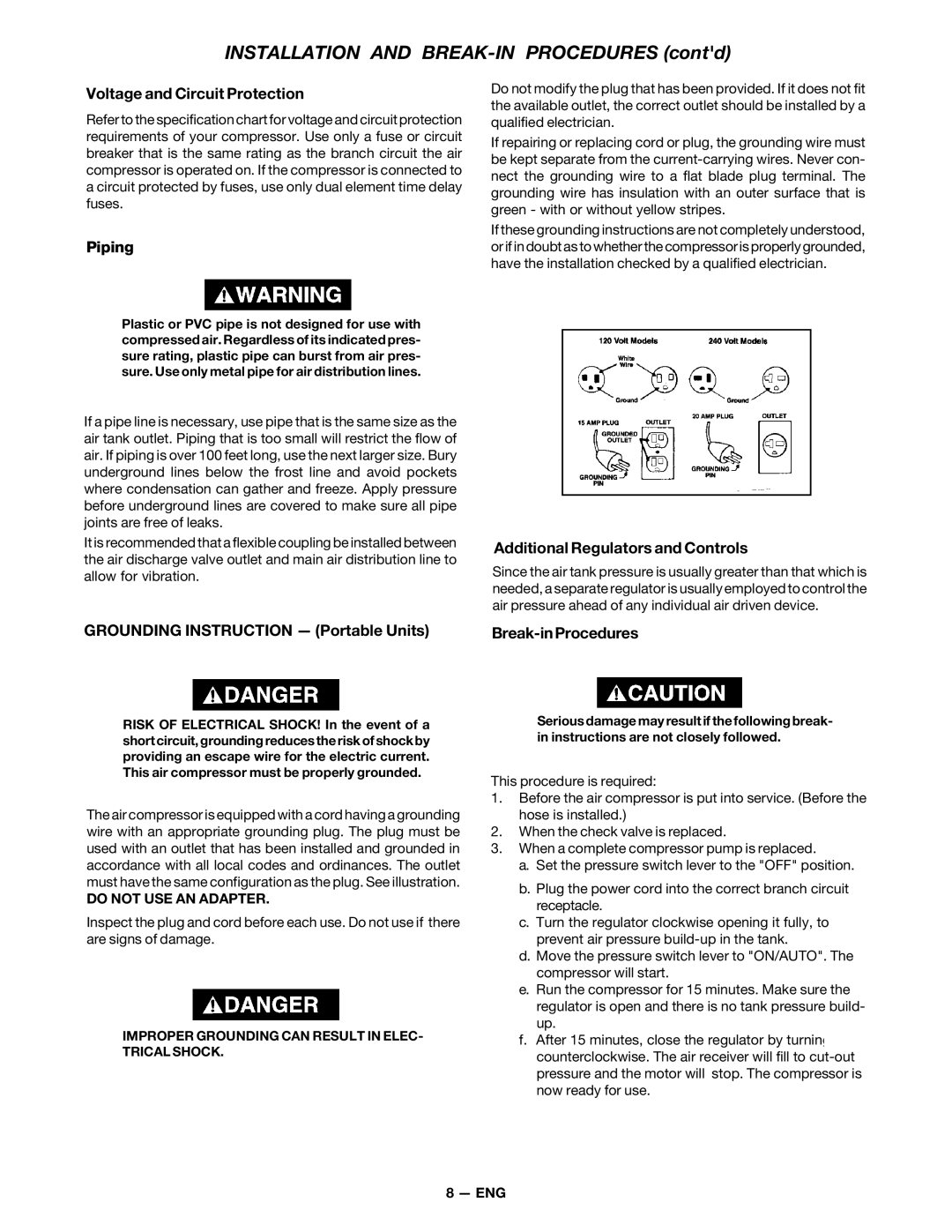
INSTALLATION AND BREAK-IN PROCEDURES (cont'd)
Voltage and Circuit Protection
Refer to the specification chart for voltage and circuit protection requirements of your compressor. Use only a fuse or circuit breaker that is the same rating as the branch circuit the air compressor is operated on. If the compressor is connected to a circuit protected by fuses, use only dual element time delay fuses.
Piping
Plastic or PVC pipe is not designed for use with compressed air. Regardless of its indicated pres- sure rating, plastic pipe can burst from air pres- sure. Use only metal pipe for air distribution lines.
If a pipe line is necessary, use pipe that is the same size as the air tank outlet. Piping that is too small will restrict the flow of air. If piping is over 100 feet long, use the next larger size. Bury underground lines below the frost line and avoid pockets where condensation can gather and freeze. Apply pressure before underground lines are covered to make sure all pipe joints are free of leaks.
It is recommended that a flexible coupling be installed between the air discharge valve outlet and main air distribution line to allow for vibration.
GROUNDING INSTRUCTION — (Portable Units)
RISK OF ELECTRICAL SHOCK! In the event of a short circuit, grounding reduces the risk of shock by providing an escape wire for the electric current. This air compressor must be properly grounded.
The air compressor is equipped with a cord having a grounding wire with an appropriate grounding plug. The plug must be used with an outlet that has been installed and grounded in accordance with all local codes and ordinances. The outlet must have the same configuration as the plug. See illustration.
DO NOT USE AN ADAPTER.
Inspect the plug and cord before each use. Do not use if there are signs of damage.
IMPROPER GROUNDING CAN RESULT IN ELEC- TRICAL SHOCK.
Do not modify the plug that has been provided. If it does not fit the available outlet, the correct outlet should be installed by a qualified electrician.
If repairing or replacing cord or plug, the grounding wire must be kept separate from the
If these grounding instructions are not completely understood, or if in doubt as to whether the compressor is properly grounded, have the installation checked by a qualified electrician.
Additional Regulators and Controls
Since the air tank pressure is usually greater than that which is needed, a separate regulator is usually employed to control the air pressure ahead of any individual air driven device.
Break-inProcedures
Serious damage may result if the following break- in instructions are not closely followed.
This procedure is required:
1.Before the air compressor is put into service. (Before the hose is installed.)
2.When the check valve is replaced.
3.When a complete compressor pump is replaced.
a.Set the pressure switch lever to the "OFF" position.
b.Plug the power cord into the correct branch circuit receptacle.
c.Turn the regulator clockwise opening it fully, to prevent air pressure
d.Move the pressure switch lever to "ON/AUTO". The compressor will start.
e.Run the compressor for 15 minutes. Make sure the regulator is open and there is no tank pressure build- up.
f.After 15 minutes, close the regulator by turning it counterclockwise. The air receiver will fill to
8 — ENG
